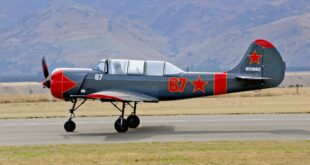In the early hours of Friday, April 5, 2024, Ukrainian forces, as reported by the Ukrainian Intelligence Services and using drones, targeted the Russian Morozovsk Air Force base in the Rostov region. The assault led to the destruction of six Russian fighter aircraft, delivering a significant blow to the military capabilities of Russia in the area. Home to the 559th Bomber Aviation Regiment, this base hosts three squadrons of Sukhoi Su-34 (NATO designation: Fullback) within the 1st Guards Composite Aviation Division.
Follow Army Recognition on Google News at this link
Picture from Google Earth, June 10, 2023, showing Su-34 and Su-27 fighter aircraft at Russian Morozovsk air force base located in the Rostov region of Russia. (Picture source Screen shot Google Earth)
The operation was jointly conducted by the Ukrainian SBU security service and military personnel, utilizing sophisticated drone technology to carry out the precision strikes. The strategic use of drones allowed Ukrainian forces to effectively penetrate Russian defenses and inflict considerable damage on the airbase.
Before the attack, open-source intelligence reports indicated that there were 26 Russian Su-34 and three Su-35 fighter jets stationed at the Russian air forec base. However, Russian officials asserted that all incoming drones and their attacks were successfully intercepted and neutralized.
Further insights from sources close to the Ukrainian Newspaper Kyiv Independent reveal that the Morozovsk airbase was not the only target in this coordinated operation. Additional drone strikes were reported against other key military airfields in Russia, including the significant Engels-2 airbase in the Saratov oblast, more than 750 kilometers from the nearest airbase under Ukrainian control. These airfields have been crucial for Russia’s military operations against Ukraine, regularly deploying warplanes for attacks on Ukrainian territory.
The intelligence reports detail the successful destruction or damage of 19 Russian warplanes in total across various locations, including three Russian Tu-95 strategic bombers at the Engels-2 airbase. These bombers have been instrumental in launching attacks against Ukraine with air-launched cruise missiles.
The strikes also reportedly resulted in casualties, with seven individuals killed or injured, among them aircraft pilots. Additionally, the military intelligence identified two other airfields as targets: one in Yeysk, in the Krasnodar region, and another near Kursk, although details on the outcomes of these strikes remain sparse.
The night-time operation also targeted the Morozovsk airbase, where Su-34 fighter-bombers and Su-27 fighters were based. These aircraft have been used by Russia to conduct aerial bombings on Ukrainian military positions and frontline cities, exacerbating the humanitarian and military crisis in the region.
The financial and operational impact of these strikes is significant, with the destroyed Su-34 and Su-27 planes each valued at over 35 million dollars. According to sources, the combined operations resulted in at least six military aircraft being destroyed and eight others damaged, alongside approximately twenty Russian soldiers reported killed or injured.
These operations highlight the increasing reliance on drone warfare and the strategic targeting of military infrastructure, marking a new phase in the conflict with potentially far-reaching consequences for both Ukraine and Russia.
In the ongoing conflict in Ukraine, the Russian Air Force has employed the Sukhoi Su-34 and Su-27 fighter aircraft extensively, highlighting their strategic importance in aerial combat and ground support operations. The Su-34, known for its advanced avionics, robust airframe, and substantial payload capacity, has been particularly used for precision strikes against key Ukrainian military and infrastructure targets. Its capability to deliver a wide range of munitions makes it a formidable tool for achieving tactical and strategic objectives.
Similarly, the Su-27, a highly maneuverable and versatile fighter, has been deployed for air superiority missions, engaging in combat to protect airspace and support ground operations. Together, these aircraft have played pivotal roles in the conflict, demonstrating the critical importance of air power in modern warfare and the substantial impact these platforms can have on the dynamics and outcome of military engagements.

In December 2023, the Army Recognition editorial team reported that Ukraine has launched massive production of localy-made kamaikaze drone. (Picture source Social Network)
In response to the limited inventory of surface-to-surface missiles and the ongoing need for effective, long-range military capabilities, Ukraine has initiated ambitious projects to develop a variety of drones, including First Person View (FPV) and kamikaze drones. These efforts reflect a strategic pivot towards leveraging drone technology as a cost-effective, rapidly deployable alternative to traditional cruise and ballistic missile systems.
Drones, particularly those designed for kamikaze missions—where the drone itself is a guided explosive device—offer several advantages over conventional munitions. Firstly, their production costs are significantly lower compared to traditional missile systems, making them an economically viable option for sustained military operations. Additionally, the development cycle for drones is generally shorter, enabling quick iterations and improvements based on operational feedback.
The evolution of drone technology within Ukraine’s defense strategy has reached a significant milestone with the development of the latest Ukrainian kamikaze drones. These drones are capable of reaching targets deep inside Russian territory, boasting an impressive range of up to 1,000 kilometers. This capability not only extends Ukraine’s reach but also provides a strategic advantage in targeting key infrastructure and military assets without the need for close proximity.
FPV drones, which allow operators to control the drone and view its flight through a first-person perspective, enhance tactical reconnaissance and precision targeting. These drones can be used for a variety of purposes, including surveillance, target identification, and assessment of battlefield conditions, thereby increasing the effectiveness and safety of military operations.
The development of these drones is a testament to Ukraine’s commitment to innovation in the face of logistical and resource challenges. By focusing on the production of FPV and kamikaze drones, Ukraine is adapting its military strategy to the realities of modern warfare, where technology and adaptability can offer a competitive edge. This strategic shift not only underscores the importance of unmanned aerial systems in contemporary conflicts but also highlights Ukraine’s resilience and ingenuity in leveraging technology to meet its defense needs.
News Russia Ukraine War
 Unmanned Aerial Vehicle The latest drone news
Unmanned Aerial Vehicle The latest drone news


